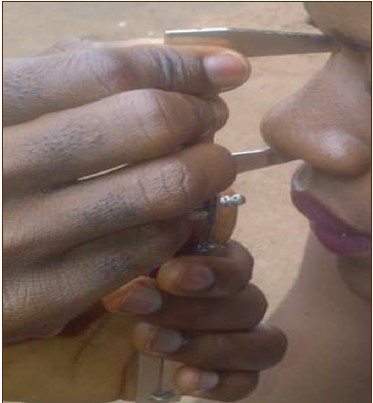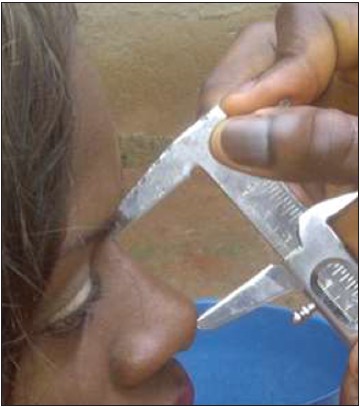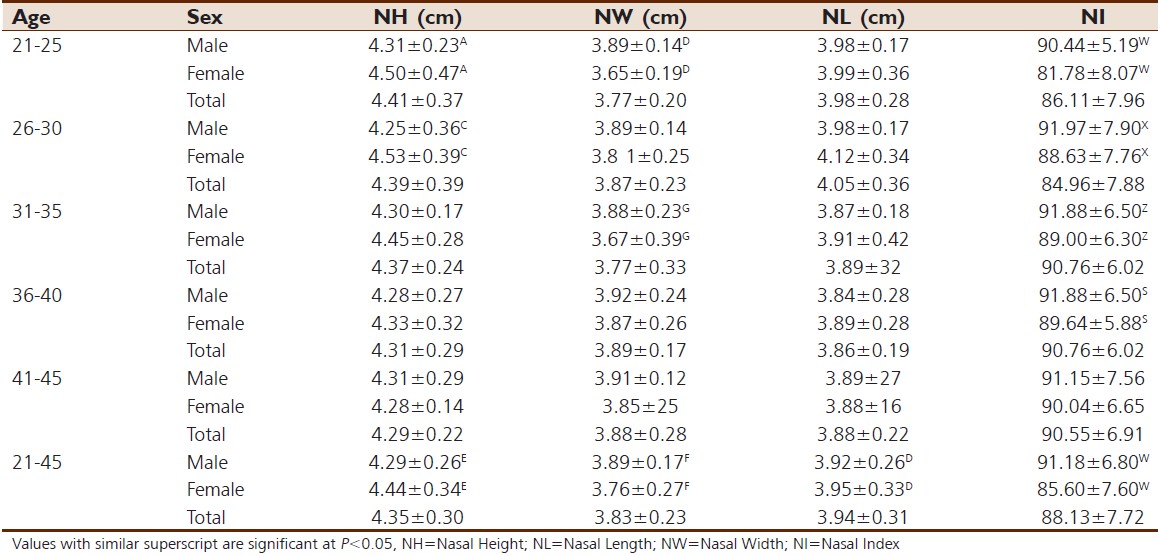|
 
 |
| ORIGINAL ARTICLE |
|
| Year : 2014 | Volume
: 2
| Issue : 1 | Page : 13-16 |
|
Anthropometric analysis of the nose of the Ejagham ethnic group in Cross River State, Nigeria
Esomonu G Ugochukwu, OM Ijomone, RA Ude, EM Nandi
Department of Anatomy, Faculty of Basic Medical Sciences, Cross River University of Technology, Okuku Campus, Cross River State, Nigeria
| Date of Web Publication | 27-Oct-2014 |
Correspondence Address:
Esomonu G Ugochukwu
Department of Anatomy, Faculty of Basic Medical Sciences, Cross River University of Technology, Okuku Campus
Nigeria
 Source of Support: None, Conflict of Interest: None  | Check |
DOI: 10.4103/2315-7992.143401

Introduction: The normal nose morphology varies in shape and size as a result of ethnic, gender, and environmental influences therefore nasal anthropometry can be employed in classifying the race and sex of the individual whose identity is unknown. This study is aimed at deriving normal standard values for the following nasal anthropometric parameters: Nose height (NH), Nose width (NW), Nose length (NL), and Nasal index (NI) across age and sex for the Ejagham ethnic group in Cross River state of South-Nigeria. Materials and Methods: One hundred subjects (50 males and 50 females) aged 21-45 years were recruited for this study, they were further divided into five age sub-groups (21-25, 26-30, 31-35, 36-40, and 41-45 years) to observe the variation of each parameter with advancing age and sexual dimorphism. Results: Sexual dimorphism was noted (P < 0.05) as higher values were observed in males in NW and NI while females showed higher value in NH and NL (P < 0.05). Age related changes were not significant. Applying the international nose anthropometric methods to assess and compare nasal morphological characteristics, both males and females mostly have platyrrhine (broad and short) nose types of NI > 85. Conclusion: This study clearly confirms that anthropometric variation exists based on sex. These measurements in healthy subjects are useful for dysmorphologist in the early identification of some dysmorphic syndromes like cleft-lip associated with nose disorders. The data generated can also provide useful information to the rhinoplastic surgeon especially when nasal reconstruction is sort for by an individual who desire to change his nasal morphology to that of the Ejagham ethnic group of Cross River State. Keywords: Ejagham, nasal index, nose height, nose length, nose width
How to cite this article:
Ugochukwu EG, Ijomone O M, Ude R A, Nandi E M. Anthropometric analysis of the nose of the Ejagham ethnic group in Cross River State, Nigeria. Ann Bioanthropol 2014;2:13-6 |
How to cite this URL:
Ugochukwu EG, Ijomone O M, Ude R A, Nandi E M. Anthropometric analysis of the nose of the Ejagham ethnic group in Cross River State, Nigeria. Ann Bioanthropol [serial online] 2014 [cited 2018 Sep 6];2:13-6. Available from: http://www.bioanthrojournal.org/text.asp?2014/2/1/13/143401 |
| Introduction | |  |
The shape of the nose is believed to be a unique feature of the ethnic origin of an individual. As such the nasal anthropometric features when studied can provide useful information to the rhinoplastic surgeon especially when nasal reconstruction is sort for by an individual who desire to change his nasal morphology to that of other race. The data correlation of nose anthropometry of various ethnic groups is therefore very useful when planning such aesthetic nasal surgery and cosmetology.
In forensic science and physical anthropology, nasal anthropometry is also a useful tool in the identification of the race, ethnicity, and gender of an individual since it has been reported that nasal anthropometry is ethnicity specific because it outlines the morphological peculiarities of the nose of a particular ethnic group. [1],[2],[3],[4] It has also been described to be gender specific. [5] Nasal anthropometry further buttresses a great foundation in facial recognition especially with modern advances in biometrics in the recent decade. For instance, in a situation of mass killing or homicides where unknown corpse are seen, apart from tracing the individual with fingerprints and DNA, nasal anthropometric study can play a role in identification.
There are three categories of nose on the basis of nasal index (NI); these are Leptorrhine with a NI of 69.90 or less, Mesorrhine with a NI between 70-84.90 and Platyrrhine (broad nose) with a NI of 85 and above. [6] A large number of reports exist on the nasal anthropometry of Nigerians. In 2009, Oladipo et al., conducted an anthropometric assessment of nasal parameters of Itsekiris and Urhobos ethnic group of Nigeria with the aim of comparing the nose type among the two ethnic groups. [2] Their results showed that on the average, Urhobos had a mean NI of 89.63% and the Itsekiris had a mean NI of 90.74%. [2] Sexual dimorphism was observed in the ethnic groups studied with males having significantly (P < 0.05) higher nasal values (NV) than the females. [2] Therefore, their work shows that the two ethnic groups fall within the same nose type which is platyrrhine (broad and short) expected of an African population. [2] Anthropometric study of the nose was also conducted by Olotu et al., in 2009 and they revealed that the nasal height (NH) for adult Igbo males was 4.87 ± 0.08 cm and 4.40 ± 0.76 cm for adult Igbo females. [3] Nose anthropometric data established for the Bini ethnic group of Nigeria shows that they have the platyrrhine nose type, with their male having a NI of 91.17 ± 1.52 and females recording 89.14 ± 1.75. [4]
The human nose has been reported to differ in its anatomy and morphology between different racial and ethnic groups. Heidari et al., analyzed the nasal morphology of 400 Baluch and Sistani aborigine women (200 subjects in each group) within the age-range of 18-25 years and revealed that the mean total length and height of the nose in the Sistani group was significantly (P < 0.001) lower than in the Baluch group while the mean nasal width (NW) in the Sistani group was higher than in the Baluch group (32.3 ± 1.3 vs 31.4 ± 1.5 mm). [1] They further reported that the NI in the Sistani group was significantly (P < 0.001) higher than in the Baluch group (69.7 ± 3.5 vs 59.2 ± 3.3). [1] The most common type of nose according to their analysis was revealed to be the leptorrhine (fine nose) which accounted for 55.5% in the Sistani group and 98.5% in the Baluch group. [1]
The present study, therefore aims to establish standards for the following nasal anthropometric parameters: NH, Nasal length (NL), NW, and NI and to study the distribution of basic nose types and shape of the Ejagham ethnic group of Cross River State so as to provide a baseline data of nasal anthropometry which could be vital in forensic and anthropological studies.
Cross River State is a coastal state in South-south Nigeria, named after the Cross River, which passes through the state. The Ejagham is one of the major ethnic groups in Cross Rivers State.
| Materials and Methods | |  |
A total number of 100 subjects were recruited for this research (50 males and 50 females) across the Ejagham Ethnic group in Cross River State. Subjects which were invited to participate in the measurement where within age of 21-45 years with normal nose configuration and both parents are indigenes of Ejagham ethnic group of Cross River State. All the measurements used for this research were taken in the morning hours; this is because individuals are presumed to be more relaxed in the morning hours than in the afternoon. The method applied for this research is the direct method using sliding caliper with the subject sitting on a chair with head in the anatomical position [Figure 1], [Figure 2], [Figure 3]. The measurements taken in this study include: NH, this is measured from the nasion and subnasale; NL, this is measured between the nasion and the pronasale; NW, measured at right angle to the NH from ala to ala. NI was calculated as follows: NW/NH times 100 (NW/NH × 100) which determines if the nose is leptorrhine (fine nose) with value <70, mesorrhine if it is between 70-85, and platyrrhine (broad nose) if it is >85. [7],[8] The data were subjected to statistical analysis using student's t-test. Statistical significance was set at P < 0.05 | Figure 1: Measurement of nose height of a 24-years-old Ejagham volunteer
Click here to view |
 | Figure 3: Measurement of nose length of a 24-years-old Ejagham female subject
Click here to view |
| Results | |  |
The mean value of the NH, NW, and NL of the Ejaghams of Cross River State are shown in [Table 1]. Ejagham ethnic group revealed that the NH was sexually dimorphic between the age groups of 21-25 and 26-30. In each of these instances, the proportion of the NH was greater in females than in males. No significant difference was noted due to advancing age. The mean NW showed sexual dimorphism in age sub-group between 21-25 and 31-35) as well as the overall age groups (21-45) with mean values for males being higher than the values recorded for females. The overall mean for NL in males is 3.92 ± 0.26 cm while in females is 3.95 ± 0.33 cm. Just like the NH, the NL is significantly (P < 0.05) higher in females than males which makes this parameter also sexually dimorphic. | Table 1: Comparison of nose height, nose width, nose length and nasal index in male and female subjects in all age groups in Ejagham Ethnic group of Central Cross River State. Two-tailed significance represented in similar superscript tells the level Sexual Dimorphism
Click here to view |
The mean and standard deviation (SD) of NI in males and females in general was determined and it was observed that the overall male value was 91.18 ± 6.80 while that of females was 85.6 ± 7.6 [Table 1]. Sexual dimorphism was noted with male having higher values than their female counterparts in the overall group, and in all the sub-groups except at age group 40-45 years where sexual dimorphism was not noted. Therefore, it is observed that the indigenes of Ejagham ethnic group of Cross River State, irrespective of sex and age, have a NI which place them in the platyrrhine class of nose.
| Discussion | |  |
The nasal profile and morphology is one of the defining features that characterize different races because it is at the center of the face. Different anthropological findings have describe the nose as a signature indicating the ethnicity, race, age, and sex of an individual. [2],[3],[7],[8],[9],[10] The morphological differences in nasal anatomy between genders cannot be over emphasized, especially in cosmetic rhinoplasty, because feminization or masculinization of the opposite sex nose might not give the desired aesthetic effect.
In the present research, there was no significant increase in any of the measured parameter as a result of age advancement but sexual dimorphism was observed with female values being higher than male values in NH and NL while male values was significantly higher than the female value in NW and in the calculated NI. This study found the male NH to be 4.29 ± 0.26 cm and that of females was 4.44 ± 0.35 [Table 1] with higher significant value noted in females than in males. These values are contrary to the values reported by Olotu et al., for the Igbos. [3] They revealed that the NH for Igbo male adult (4.87 ± 0.84 cm) were significantly higher than that of Igbo females (4.40 ± 0.76 cm). [3] The mean NW for the present work was found to be 3.89 ± 0.17 cm for males and 3.76 ± 0.31 cm for females. The values were significantly higher in males (P < 0.05). Akpa et al., in 2005, also revealed that Igbo males have a higher mean NW than the Igbo females. [11] Oladipo et al., study on the Itsekiris and Urhobos recorded 4.01 ± 0.14 cm and 3.99 ± 0.40 cm respectively for the NW, [2] if compared to that of the Ejagham ethnic group it is obvious that Ejagham ethnic group has a lower NW. But when compared to the work of Heidari et al., it becomes obvious that the Ejaghams have a higher NW than the Sistanis and Baluchs. [1] This shows that variation exist in the NW of different ethnic groups. The shape of the nose of an African just like those of other races are said to be influenced by the environmental climate condition. [7] The broader nose of the Africans could be as a result of a natural selection that favors their warm and moist environment. [12] The shape of the nose is a function of the NI and in anthropology it is used in distinguishing racial and ethnic differences. [7],[13] The NI also exhibits sexual differences that's make it a viable tool in Forensic Science towards gender differentiation. [5],[14] The present study showed that the NI of the male are significantly higher than that of female across all the age sub-groups [Table 1]. This is in line with the reported values for the males from Igbo, Ijaw, and Yoruba ethnic groups in Southern Nigeria which also have significantly higher NI than their female counterpart (P < 0.05). [15] Sexual dimorphism was also observed in the NI of Itsekiris and Urhobos of Nigeria, with males having significantly higher NI values than females. [2] The NI value reported for the Ejaghams irrespective of sex is 88.13 ± 7.72 cm, this NI value does buttress their African origin because it has been reported that Africans mostly have the Platyrrhine nose type which is the broad nose with NI above 85. [16] Other Nigerian ethnic group that have platyrrhine nose type include the Igbos, Ijaws and Yoruba, [15] the Okrikas, [2] and Bini ethnic group. [4] Although cases messorrhine nose type have been reported amongst Nigerian subjects. [2],[17]
Findings of this study and the comparison of the NI with other works have shown that though anthropological difference exist in the values of the NI they still fall within the platyrrhine type of nose prevalent in the African continent.
In conclusion, this study have shown significant differences in Ejagham male and female nasal parameters indices. The Ejagham ethnic group falls under the platyrrhine (broad nose) which is the typical African nose type. This study was carried out using standard anthropometric method, hence this result is recommended to forensic experts especially with the recent interest in employing biometrics as a tool in national identification. It can also be useful to the plastic surgeon who might want to create the Ejagham type of nose for his patient.
| References | |  |
| 1. | Heidari Z, Mahmoudzadeh-Sagheb H, Khammar T, Khammar M. Anthropometric measurements of external nose in 18-25-year-old Sistani and Baluch aborigine women in the southeast of Iran. Folia Morphol (Warsz) 2009;68:88-92. 
|
| 2. | Oladipo GS, Eroje MA, Fawehinmi HB. Anthropometric comparison of the nasal indices between the Adoni and Okrika ethnis groups of Rivers State, Nigeria. Int J Med Sci 2009;1:135-7. 
|
| 3. | Olotu JE, Eroje A, Oladipo GS, Ezon-Ebidor E. Anthropometric study of the facial and nasal length of adult Igbo ethnic group in Nigeria. Internet J Biol Anthropol 2009;2. 
|
| 4. | Omotoso DR, Oludiran OO, Sakpa CL. Nasofacial Anthropometry of Adult Bini Tribe in Nigeria. Afr J Biomed Res 2011;14:219-21. 
|
| 5. | Zhang XT, Wang SK, Zhang W, Wang XF. Measurement and study of the nose and face and their correlations in the young adult of Han nationality. Plast Reconstr Surg 1990;85:532-6. 
|
| 6. | Porter JP, Olson KL. Analysis of the African American female nose. Plast Reconstr Surg 2003;111:627-8. 
|
| 7. | Ofodile FA, Bokhari F. The African-American nose. Part II. Ann Plast Surg 1995;34:209-18. 
|
| 8. | Ochi K, Ohashi T. The effects of an external nasal dilator and nasal dimensions in Asian. Otolaryngol Head Neck Surg 2002;126:160-3. 
|
| 9. | Ferrario VF, Sforza C, Poggio CE, Schmitz JH. Three-dimensional study of growth and development of the nose. Cleft Palate Craniofac J 1997;34:309-17. 
|
| 10. | Leong SC, Eccles R. The use of race as a demographic variable in clinical research. Rhinology 2010;48:3-6. 
|
| 11. | Akpa AO, Ugwu C, Maliki SO. Morphometric study of the nasal parameters in Nigerian Igbos. J Exp Clin Anat 2003;2:24-5. 
|
| 12. | Hall RL, Hall DA. Geografic variation of native people along the Pacific Coast. Hum Biol 1995;67:407-26. 
|
| 13. | Franciscus RG, Long JC. Variation in human nasal height. Am J Phys Anthropol 1991;85:419-27. 
|
| 14. | Xu B, Wang Y, Ma J, Li M, Xu L. A computer-aid study on the craniofacial features of Archang race in Yunnan province of China. Hua Xi Kou Qiang Yi Xue Za Zhi 2011;19:394-6. 
|
| 15. | Oladipo GS, Olabiyi AO, Oremosu AA, Noronha CC. Nasal indices among major ethnic groups in Southern Nigeria. Sci Res Essay 2007;2:20-2. 
|
| 16. | Risely HH. 1915. The People of India. In: Crooke W, editor. 2 nd ed. Munshiram Manoharlal publ., New Delhi: 1969. p. 395-9. 
|
| 17. | Oladipo GS, Chinagorom E, Iruoghene GO. Craniofacial dimensions of Ijaw children of Nigeria. Biomed Int 2010;1:25-9. 
|
[Figure 1], [Figure 2], [Figure 3]
[Table 1]
|